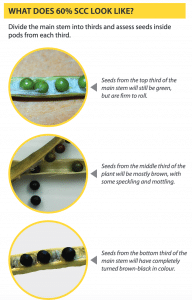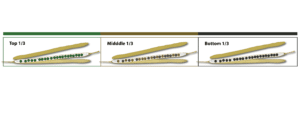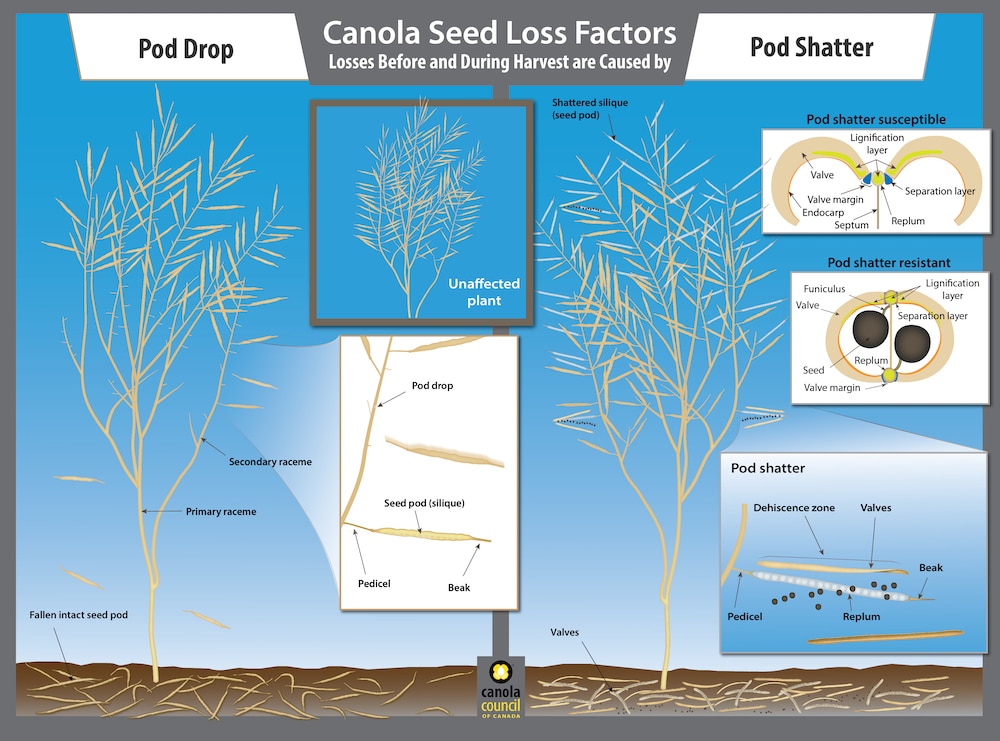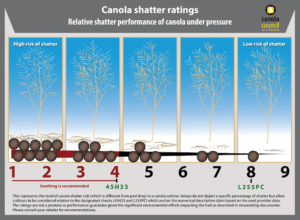Canola achieves optimum seed yield and quality when swathed at 60 per cent seed colour change (SCC), or later.
To assess SCC, divide the main stem into thirds and look at the seeds from each third. At 60 per cent SCC, seeds from the top third of the main stem will still be green but firm to roll. Seeds from the middle third will be mostly brown, with some speckling and mottling. Seeds from the bottom third, the most mature, will have completely turned brown‑black in colour. More images and tips.

Seed colour change will typically increase by about 10 percentage points every two to three days (quicker under hot dry conditions, slower under cool moist conditions), so waiting a week can provide a big boost in yield and potential profit.
Evidence for the yield benefit
The Canola Council of Canada set the 60 per cent target based on a multi-location study from the early 2000s. The study found that canola swathed at 50-60 per cent SCC on the main stem yielded at least eight per cent more than fields swathed at 30-40 per cent SCC. Canola swathed at 60-70 per cent SCC yielded 11 per cent more than fields swathed at 30-40 per cent.
The Yield and quality of canola seed as affected by stage of maturity at swathing paper by Vera et al. also concluded that premature swathing led to reductions in seed yield, seed weight and seed quality.
Newer research has confirmed these results. Indian Head Agricultural Research Foundation (IHARF) in 2013 compared two swath timings – 20-30 per cent SCC and 50-60 per cent SCC – in a study on straight combining canola. IHARF concluded that “swathing at 20-30 per cent SCC resulted in the lowest seed yield, and postponing the operation by less than a week during this critical period increased canola yields by nearly nine per cent.” The yield gain came from increased seed fill. In more recent BASF trials using hybrids with and without the pod-shatter trait, the company compared three treatments – swathing at 60 per cent SCC, swathing at 80 per cent SCC, and straight combining. BASF says 60 per cent SCC is the “sweet spot” for hybrids without the pod-shatter trait. For hybrids with the pod-shatter trait, the trials showed higher yields for canola swathed at 80 per cent and highest yields for canola straight combined.
The yield benefit from waiting is probably even greater in fields with fewer plants. With fewer bigger plants, more yield is coming from side branches, and delayed swathing gives these seeds more time to fill.
Higher yield isn’t the only benefit from waiting. Canola swathed later also tends to have slightly (emphasis on slightly) higher oil content and lower green seed counts. Canola Digest describes these other benefits. Seed chlorophyll content, which is the major quality factor to consider when it comes to harvest timing, tends to be elevated when swathing too early (with minimal seed colour change) and on a hot day. This can cause the crop to cure too fast for green to clear.
Results from the Manipulating agronomic factors for optimum canola harvest timing, productivity and crop sequencing project will provide insights on current cultivars, once available.
Why are some fields cut early?
The Canola Council of Canada surveyed 1,000 growers in 2020, and found that 81 per cent of canola growers swath all or some of their canola acres. Of the those who swath, 10 percent swath based on a target SCC of 30 percent or lower, 26 percent target 31-50 percent and 15 percent target 51-59 percent. In total, half of the growers who swath have a target of less than 60 per cent. Why?
Growers with a lot of acres to harvest may want to get harvest moving by cutting some fields before 60 per cent SCC. In that situation, they may want to start with fields where more of the seeds in side branches are firm and where overall field maturity is relatively even. Fields that are uneven (with a lot of mushy seeds in side branches) would be best left to mature a little more – especially if the canola has a pod-shatter tolerance trait.
Weather conditions may also force growers into a situation where they have to cut early. With cool harvests that delay seed colour change, canola may need to be swathed before 60 per cent SCC to get the crop dried down before a killing frost. Note, however, that the crop needs to dry down to a seed moisture level of 20% or less to be relatively safe from the damaging effects of frost. This can take three good drying days, so swathing has to occur at least three days before the frost to achieve this benefit. More on frost at harvest.
Earlier swathing does mean earlier combining. Swathing a week earlier usually means the field can be combined three or four days earlier. However, as noted, canola swathed earlier will have lower yields.
Flexibility to adjust plans based on the weather is essential. However, if growers set a target of 60 per cent SCC (or more), overall canola yields for the farm should increase – even if some fields in some years have to be swathed earlier.
Straight combining
Straight combining is a common canola harvest practice on the Prairies, with pod-shatter tolerance giving it a boost in popularity. A new comparison scale gives cultivars a 1-9 rating based on their level of pod-shatter tolerance. Cultivars with a higher score can be swathed later or straight combined, which reduces the shatter loss risk for the most mature pods and enhances the yield advantage for later cutting. More on straight combining.
More…
- Canola Encyclopedia section on harvest timing
- CCC’s Guide to Managing Canola Harvest
- Harvest management research on the Canola Research Hub
- Grower survey identifies big agronomy challenges (including swath timing)
- Don’t cut canola too soon, Country Guide





